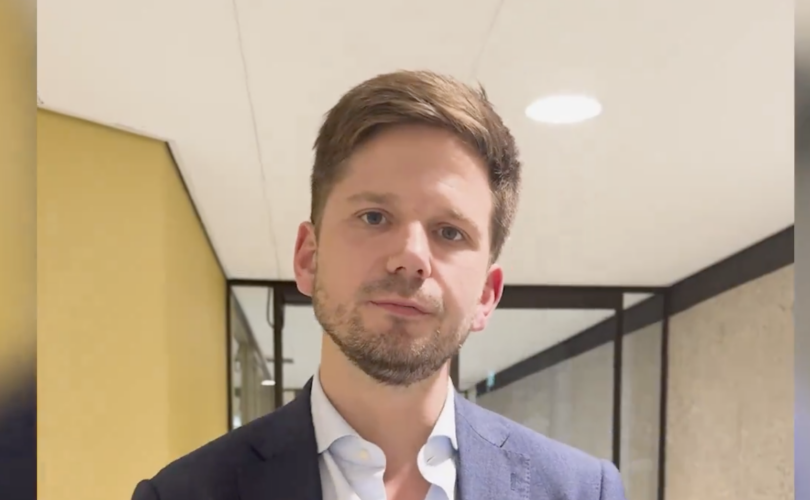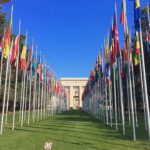Abortion, American Politics
Dutch MP silenced for exposing reality of abortion releases powerful pro-life video
A Dutch parliamentarian who was prevented from speaking about abortion during a committee meeting on medical ethics held in the Dutch House of Representatives released a viral video explaining why he was silenced—and laying out the barbarism of abortion in detail. It is easily one of the most honest and powerful denunciations of abortion delivered by a European politician in recent years.
The committee meeting was held on January 15, and the agenda included discussions on the annual reporting of abortion figures, euthanasia numbers, and embryonic research. Each committee member was to be given a four-minute speaking slot, after which other members could ask them questions. Gideon van Meijeren, an MP with the Forum for Democracy Party (FvD), used his time to bring up the growing number of abortions in the Netherlands.
“Today we debate medical ethics and in essence that concerns the question of what is right and what is wrong medically,” Van Meijeren told the committee. “I would like to ask attention for the unbelievably late abortion limit permitted in the Netherlands. And before I go there, I would like to note that no doubt every woman who finds herself in an emergency situation due to an unplanned pregnancy deserves help, support, and counseling. What matters to me most is to be able to choose a solution that protect the mother as well as the unborn child.”
“The Netherlands is the only country in the European Union where abortions are permitted until 24 weeks,” he continued. “In most countries surrounding us there’s a limit of 10 or 12 weeks. And to illustrate I have here an anatomical model of a fetus.” He reached into his bag and retrieved a model fetus, at which point the chair, MP Mohammed Mohandis, immediately interrupted.
“May I stop you,” Mohandis said quickly. “No, wait. It’s not allowed. You know that. You must take it off the table. No pictures, I’ll tell you now. No images. No videos. That is the case in the House for a very long time already. You must take it off the table. Yes, I said adjournment so the livestream must be off for a moment.” He ordered Van Meijeren to put the model on the ground, out of view. At one point, another committee member reached out to physically push the plastic pre-born baby out of sight. The livestream was cut so viewers would not see it.
Van Meijeren informed the committee that the House should not shut their eyes to “hard truths if we want to be able to make responsible decisions,” and pointed out that although graphics are not permitted, objects can be. Mohandis told him that he would not be permitted to use the model, and could only make his case in words. Van Meijeren told the committee that his freedom of expression was being restricted and left the meeting in protest, stating, “I will share about these hard truths via other platforms.” (These comments, and the transcript of Van Meijeren’s subsequent video, were translated by my colleague Maaike Rosendal.)
Van Meijeren did just that, and his video includes both footage of the committee meeting and a description of what abortion actually does to a pre-born child. It has now racked up over 70,000 views on X. The chair, incidentally, is a member of the pro-abortion Dutch Labour Party, which has fought for increased availability of the abortion pill and worked to abolish the mandatory five-day reflection period once required before procuring an abortion.
“Of course, it is not news to me that other MPs want to close their eyes for reality but that they would react with so much panic to demonstrating an anatomical model of a 22-week-old fetus is revelatory,” Van Meijeren said. “The fetal model in itself is of course not shocking at all. What is shocking is that these babies are being killed in the Netherlands on a daily basis. That is why the model may not be shown. That is why the livestream was immediately turned off. And that they hid behind the format — that you may not show any objects. That, of course, is nonsense. Rules about this are nonexistent. Objects are regularly permitted.” If he had attempted to show a birdhouse or some other object, he noted, nobody would have objected.
“I had the choice to either stay and deliver a weakened version of my statement without visual support, or to leave the debate and in this way share the stronger, full-fledged version of my statement with you,” he continued. “Especially regarding this kind of topic — it’s about medical ethics — about right and wrong, about life and death, it is of the greatest importance to be fully and honestly informed. This is not about shocking but rather about taking responsibility for the decisions that are made here in this House. It is important that such a debate doesn’t remain stuck in abstract terms. Often, euphemisms are used regarding abortion, a clump of cells — no, that’s not what this is about.”
Van Meijeren then laid out, in detail, the horror of legal abortion in the Netherlands:
As you saw, I was interrupted at the moment that I wanted to show this anatomical model of a fetus of 22 weeks. This is a model to scale: it is 19 centimeters from crown to tailbone, and when the legs are fully stretched out, even 29-30 centimeters. That’s what we’re talking about. In this stage of pregnancy everything is there: from the fingernails to the eyelashes, the organs are almost fully formed and are preparing for life outside the womb. The small child can yawn, stretch, hold something firmly, hear sounds, even recognize the voice of the mother, and yes, the child in this stage of pregnancy can also experience pain.
At this point, Van Meijeren referenced a 2020 paper by Derbyshire & Bockman in the Journal of Medical Ethics, highlighting the evidence that pre-born children can experience pain as early as 12 weeks. He then laid the fetal model on his desk, facing the camera. His description of abortion, which few politicians in Europe would dare to detail publicly, is worth quoting in full:
With a pregnancy of 13 weeks onward the child is too big to be sucked out through vacuum suction and that’s why, usually from 13 weeks onward, from the second trimester of pregnancy onwards, a so-called instrumental abortion is chosen (meaning, with an instrument— so surgical abortion.) For this, the doctor uses this tool, a rust-free steel abortion tool of 33 centimeters long, with a grasping part of 5 cm with sharp teeth so that whatever is grabbed will not be let go.
The doctor inserts this tool into the womb to blindly, relying on touch, grab something and with the necessary force rip that off in order to remove it. Then he grabs a little arm, then a little leg, then the torso, until the entire body is removed. However, the small head is too large at that point to be removed through the cervix intact and that’s why the forceps are used to crush the head before it is removed. And as I said, the unborn child can at that point already experience pain.
The process that I just described and shown is no exaggeration. This is how it happens. And it is certainly no exception. It is not something that very seldomly happens. This is a daily reality in the Netherlands. Every day this takes place. In 2023 alone (the most recent numbers available to us) more than 5,000 unborn babies in the second trimester were killed in this way. Of the more than 39,000 abortions/year in the Netherlands, a number that has been increasing for years, 39,000 — that is on average an abortion every 15 minutes, 24 hours a day, 7 days a week, 365 days a year.
That poses the question whether abortion is chosen too easily. Based on the law, abortion is only permitted if the emergency of the situation of the woman makes an abortion unavoidable. The law also dictates that prior to every abortion, careful consideration must be made whether there are no other solutions.
Van Meijeren went on to observe that while motivations for abortion vary — from frivolous to serious — we should be able to collectively agree that we should strive for solutions “other than killing the baby.” He concluded:
This is what I wanted to say this afternoon during the debate: not to show but to create awareness. Because ethics are about creating boundaries. And to violently kill unborn babies in the second trimester of pregnancy, even when there’s no emergency situation, of course exceeds all ethical boundaries. Forum for Democracy has a few concrete proposals to improve this situation and for that I want to propose two motions at the plenary part of the debate, and that will be accompanied by a moral call to my fellow public servants to show the courage to call a stop to this terrible evil.
Van Meijeren himself is certainly exhibiting such courage, and it is clear that the committee chair’s decision to censor his statement has resulted in the Streisand effect — I doubt that tens of thousands of people regularly tune in to watch committee ethics meetings, but many times that have already viewed his video online. Pre-born children have precious few voices raised in their defense, and even those who identify as pro-life frequently shy away from detailing the atrocities perpetrated against them. We can only hope that many more will be inspired by his courage and honesty and join their voices to his.









Shalom Jonathon!
Bless you for your commitment to Righteousness regarding the sanctity of life, even life in the womb! It is encouraging to see there are others in the world who realize this universal TRUTH and are willing to take a STAND FOR RIGHTEOUSNESS, TRUTH, & JUSTICE, especially for the unborn, who are precious living beings. I would like to share with you what our Creator has told us what He thinks about LIFE, and what abortion is to Him, from a message I received from one of His righteous servants and intercessors, Kathleen Mitchell, October 2021, that I sent to my email list soon after by the title LIFE, LIBERTY, AND . . . DEATH?? I hope this will encourage you, as well as help your cause, and convince others that they need to get into Right alignment with what The Righteous ONE has to say and do things His Way!!
Blessings to you and yours!
Kathryn 1.23.25
This is the message from The Almighty Elohim, our — ALL humans — Creator!!:
Rhema … received 10.20.21 9:00 AM … Entrusted to Kathleen D. Mitchell
Little ones, AWAKEN! Come! Attend to My Voice! Come to hear My Word! The hour has come. It has arrived as you have requested. The war, against this wicked takeover of your world, has now come to the edge of its fullness. The angelic hosts are poised to engage as never before. The spiritual realm is bristling with the activities of spiritual war that will be reflected in the world’s battle against tyranny. My Hand is raised up against the wicked, and is about to descend with a sharp blow. It will be decisive and swift. I have heard the cries of My children; pleading for freedom from this bondage. My timing of engagement will be perfect! The cup of wickedness has now overflowed. The strongholds of the evil ones are now accessible, as their strategies and activities have entrapped the perpetrators through their zealous overkill. How long will I delay in striking the definitive blow? You have a role to play in that timing.
The timing of My strike against evil depends upon what you will do, little ones. Will you arise and finally push back to refuse this illegal power being wielded over you? Are you tired now of complying to evil judgement, rules, and operations? This is your moment. What will you risk? What will you dare in taking a stand for Life, for Truth … and for Liberty in both of those two things? For too long you have enjoyed the blessings of license, and believed it to be liberty. You had the freedom of license to do what you pleased, and to ignore what was inconvenient for your lifestyle. Have you now seen the effects of your apathy? Are you now repentant for ignoring the degradation and evil, which has been continually working against My Kingdom in your world? Now that the oppression has personally impacted your lives, are you willing to engage in a strong resistance, and in a total rejection of evil’s agendas and advances? RISE UP! Do not arise merely so that your comforts and prosperity might be restored. Rise up, because if you do not, TRUTH and RIGHTEOUSNESS will be eliminated from your world. Value what I value. I value souls, and their freedom to KNOW ME. I value the lives, which I have created for My Glory … lives not created for human self-satisfaction and comforts.
Know this: Know that LIFE is a key issue at stake in this battle. For too many years, you have ignored the slaughter of My little ones in the womb. You brushed off their suffering, and were content to believe the lies; reporting that these creations were merely collections of human tissue in the womb, and not yet living beings. WRONG! From the moment that two parent cells join, I trigger life to bloom by Divine spark. These little collections of human tissue are MY CREATION … MY little ones! Through abortion, you have given permission for the spirit of Death to enter into your societies; so, death is what you have reaped throughout your world. Your complacency, in regard to these little lives in the womb, has literally fed the beasts, who now seek to control your world and to depopulate it. The blood of My little ones has literally comprised the substance of both the food, and profits, of these evil monsters. So now you want Me to break this yoke of Death that is being thrust upon your world, and injected into your bodies? So, now human life is precious to you, because it is your own lives being threatened? Are rights and liberties now a concern for you, after so many years of unconcern for the rights and liberties of life for the unborn?
I have been waiting to hear travail arising from recognition of the great evil that you have allowed for so many years. I sent you precious packages in the womb, but you shattered them and returned the tiny souls to Me … rejected, inconvenient, and unappreciated. Do you not understand what you have done? What you have legalized? What you have sanctioned? I sent you treasure, but your world treated it as dung, or as a product to be sold and used wickedly for evil purposes. There is no excuse. My Spirit has been crying out against this evil practice of child slaughter without ceasing. Death is what you allowed to devour your unborn. Now Death is exerting its legal right to devour your populations.
I AM Love. I AM rich in Forgiveness. I hate evil. I AM Mercy but this slaughter MUST STOP! You are finally raising up voices against the tyranny, which is seeking to seize your lives and liberties. What voices do the children in the womb have, if not yours? Abortion is a tyranny that has stolen the lives and liberty of many millions of My little ones in the womb. Since you did not consistently respect, and love, the fruit of the womb, your wombs may now be unfruitful, because of these poisons being injected into your bodies. Since you did not protect the children in your wombs, the children in your arms may be taken from you, as these poisons are now being given to them.
CRY OUT NOW! Cry out now … not just for your lives and liberties! Cry out now … not just for truth about this wicked injection, depopulation, and takeover agenda. Cry out now for the lives of the unborn, and for the truth of what child slaughter in the womb really is. It is NOT a right, NOR an option. It is NOT about personal opinion, dogma, or philosophy. It is NOT about women’s health any more than the Covid attack has been about protecting human health. Both agendas are about murder. Do you not see the connection? Did I not say that what you sow, you shall then reap? The door to this satanic agenda, which is raging against your world, and against your very lives, was opened by your choice to surrender your unborn children to Molech.
Understand this truth most clearly. Does that truth OFFEND YOU? Your lack of willingness to make the connection offends Me. Humble yourselves … all of you, who claim My Name as being the identity of your God. What you have allowed to be done to the least of these little ones, you have done to ME. Fighting against this satanic Covid agenda is not about saving your world. It is about saving souls from eternal separation from Me. Therefore, your protests against this global tyranny must be about murder. It’s not just to be about your lives and freedoms being preserved. It must also be about the lives and freedoms of the murdered unborn being restored. You will not have one without the other. The specter of oppression, subjugation to unholy power, and death will remain, hanging over your head, until you deal with this great sin of abortion. If it offends you to hear My Word on this matter, then you do not have My Heart, nor know it. I AM LIFE and I AM LOVE. If you will not honor My Lordship, My Priorities, and My Heart for your human creations, you will suffer increasing losses until you do.
Pray for this revelation to be poured out into the hearts and minds of the people. Pray for their eyes to see the horror of the slaughter, and the utter horror of the profiteering from this slaughter. Pray that the truth regarding this innocent blood … which is that it is being spilled for satanic worship, for profit, and also being consumed … will sicken the people to the point of vomiting. The populations of the world must know this truth. Who will speak it without compromise? Who will rend their garments and travail until the revelation is poured out and realized?
I extend Mercy to those who are deceived. But once the truth has been given to the blind and ignorant, the clock starts ticking, as I await their response to the truth. If they do not act … if they ignore and reject the truth … judgments will be released to impress the arrogant, and the rebellious, of the need for them to change course.
The clock is ticking, little ones. My Mercy has been extended. Speak out the truth and pay the price for it. Do not allow the lying voices of evil to prevail over yours. I will be standing with you … empowering you and supporting you. You must be voices for those who do not yet have a voice from within the womb. There is no more delay.
If I would withdraw My Hand … if I would bring recompense for the sin committed against the unborn … the number of the aborted children would quickly become the number of dead citizens lying in your streets. That is NOT what I want to happen. Therefore, warn the leadership of the Body to repent for their role in tolerating abortion. Call the Body at large to come to their faces in confession of the sin that has been allowed, and tolerated, on their watch. I will be swift to forgive, and quick to turn the tide. My armies are at the ready to engage against the tyrants of your world, but until the legal right, claimed by the Enemy, is removed through recognition and repentance of the evil that has been done to the unborn, the tyranny will continue. I want it to END. Change course NOW! If you, the Remnant, will fulfill your calling by speaking out and interceding, My Spirit of Truth will be poured out. ABORTION WILL STOP, as will the plague of Death and Control, which is consuming your world. Stand forth and engage!”
In some places, it is illegal to commit an indignity to a body. A number of years ago I read about people in a neighbourhood in Washington, D.C., complaining about a stench. It turned out that a dumpster had not been emptied because of a holiday. It was behind an abortion clinic. There were aborted babies rotting in a dumpster in the hot sun.